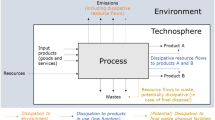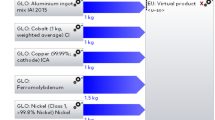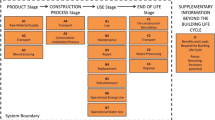Abstract
Background, aim and scope
The mining sector provides materials that are essential elements in a wide range of goods and services, which create value by meeting human needs. Mining and processing activities are an integral part of most complex material cycles so that the application of life cycle assessment (LCA) to minerals and metals has therefore gained prominence. In the past decade, increased use of LCA in the mineral and metal sector has advanced the scientific knowledge through the development of scientifically valid life cycle inventory databases. Though scientifically valid, LCA still needs to depend on several technical assumptions. In particular, measuring the environmental burden issues related to abiotic resource depletion, land use impacts and open-loop recycling within the LCA are widely debated issues. Also, incorporating spatial and temporal sensitivities in LCA, to make it a consistent scientific tool, is yet to be resolved. This article discusses existing LCA methods and proposed models on different issues in relation to minerals and metals sector.
Main features
A critical review was conducted of existing LCA methods in the minerals and metals sector in relation to allocation issues related to indicators of land use impacts, abiotic resource depletion, allocation in open-loop recycling and the system expansions and accounting of spatial and temporal dimension in LCA practice.
Results
Evolving a holistic view about these contentious issues will be presented with view for future LCA research in the minerals and metals industry. This extensive literature search uncovers many of the issues that require immediate attention from the LCA scientific community.
Discussion
The methodological drawbacks, mainly problems with inconsistencies in LCA results for the same situation under different assumptions and issues related to data quality, are considered to be the shortcomings of current LCA. In the minerals and metals sector, it is important to increase the objectivity of LCA by way of fixing those uncertainties, for example, in the LCA of the minerals and metals sector, whether the land use has to be considered in detail or at a coarse level. In regard to abiotic resource characterisation, the weighting and time scales to be considered become a very critical issue of judgement. And, in the case of open-loop recycling, which model will best satisfy all the stake holders? How the temporal and spatial dimensions should be incorporated into LCA is one of the biggest challenges ahead of all those who are concerned. Addressing these issues shall enable LCA to be used as a policy tool in environmental decision-making. There has been enormous debate with respect to on land use impacts, abiotic resource depletion, open-loop recycling and spatial and temporal dimensions, and these debates remain unresolved. Discussions aimed at bringing consensus amongst all the stake holders involved in LCA (i.e. industry, academia, consulting organisations and government) will be presented and discussed. In addition, a commentary of different points of view on these issues will be presented.
Conclusions
This review shall bring into perspective some of those contentious issues that are widely debated by many researchers. The possible future directions proposed by researchers across the globe shall be presented. Finally, authors conclude with their views on the prospects of LCA for future research endeavours.
Recommendations and outlook
Specific LCA issues of minerals and metals need to be investigated further to gain more understanding. To facilitate the future use of LCA as a policy tool in the minerals and metals sector, it is important to increase the objectivity with more scientific validity. Therefore, it is essential that the issues discussed in this paper are addressed to a great detail.



Similar content being viewed by others
References
Atherton J (2007) Declaration by the metals industry on recycling principles. Int J Life Cycle Assess 12(1):59–60
Azapagic A, Clift R (1999) Allocation of environmental burdens in multiple-function systems. J Cleaner Prod 7(2):101–119
Bare JC, Pennington DW, Udo de Haes HA (1999) Life cycle impact assessment sophistication—international workshop. Int J Life Cycle Assess 4(5):299–306
Bauer C, Zapp P (2004) Generic characterisation factors for land use and water consumption. In: Dubreuil A (ed) life cycle assessment of metals—issues and research directions. SETAC USA, Pensacola, pp 147–152
Birat JP, Prum N, Chiappini M, Yonezawa K, Aboussouan L (2005) The value of recycling to society and its internalisation into LCA methodology. Presented at SETAC North-America 26th annual meeting, 13–17 November. Maryland, USA, pp 50–61
Bjorklund AE (2002) Survey of approaches to improve reliability in LCA. Int J Life Cycle Assess 7(2):62–72
Boguski TK, Hunt RG, Franklin WE (1994) General mathematical models for LCI recycling. Resour Conserv Recy 12:147–163
Brent AC, Hietkamp S (2006) The impact of mineral resource depletion. Int J Life Cycle Assess 11(5):361–362
Brentrup F, Küsters J, Lammel J, Kuhlmann H (2002a) Impact assessment of abiotic resource consumption—conceptual considerations. Int J Life Cycle Assess 7:301–307
Brentrup F, Küsters J, Lammel J, Kuhlmann H (2002b) Life cycle impact assessment of land use based on the Hemeroby concept. Int J Life Cycle Assess 7(6):339–348
Curran MA (2007) Co-product and input allocation approaches for creating life cycle inventory data: a literature review. Int J Life Cycle LCA 12(Special 1):65–78
Dubreuil A (ed) (2005) Life-cycle assessment of metals: issues and research directions. Society of environmental toxicology and chemistry (SETAC), Pensacola, p 307
Dubreuil A (2007) Eco-material selection: a framework for a comparative assessment of metals autoparts. Presentation made during 3 rd NEDO International Workshop, Ishigaki Island, Japan, October 30–31, 2007
Ekvall T (2000) A market-based approach to allocation at open-loop recycling. Resour Conserv Recy 29:91–109
Ekvall T, Finnveden G (2001) Allocation in ISO 14041—a critical review. J Cleaner Prod 9:197–208
Ekvall T, Tillman AM (1997) Open-loop recycling: criteria for allocation procedures. Int J Life Cycle Assess 2(3):155–162
Finnveden G (1996) Resources and related impact categories, part II. In: Udo de Haes HA et al (eds) Towards a methodology for life cycle impact assessment. Report of the SETAC-Europe working group on Life Cycle Impact Assessment (WIA). SETAC-Europe, Brussels, Belgium
Finnveden G (2005) The resource debate needs to continue. Int J Life Cycle Assess 10(5):372
Furuholt E (1995) Life cycle assessment of gasoline and diesel. Resour Conserv Recy 14:251–263
Giudice F, La Rosa G, Risitano A (eds) (2006) Product design for environment—a life cycle approach. Taylor and Francis, New York, p 87
Guinée JB (ed) (2002) Handbook of life cycle assessment–operational guide to the ISO standards. Kluwer, Dordrecht
Heijungs R, Sleeswijk AW (1999) The structure of impact assessment: mutually independent dimensions as a function of modifiers. Letters to the editor: comment and reply. Int J Life Cycle Assess 4(1):2–3
Høgaas EM, Ohlsson T (1998) Comparison of two different approaches to inventory analysis of dairies. Int J Life Cycle Assess 3(4):209–215
Huijbregts M (1998) Application of uncertainty and variability in LCA. Part I: a general framework for the analysis of uncertainty and variability in life cycle assessment. Int J Life Cycle Assess 3(5):273–280
Huppes G (1996) LCA Yesterday. Today and tomorrow. Centre of Environmental Science, Leiden University, Leiden, pp 29–49
Huppes G and Schneider F (eds) (1994) Proceedings of the European Workshop on Allocation in LCA. Leiden
ISO 14040 (2006a) Environmental management—life cycle assessment—principles and framework. ISO, Geneva
ISO 14044 (2006b) Environmental management—life cycle assessment—requirements and guidelines. ISO, Geneva
Jacobs J (1969) The economy of cities. Randon House, New York
Jolliet O, Müller-Wenk R, Bare J, Brent A, Goedkoop M, Heijungs R, Itsubo N, Peña C, Pennington D, Potting J, Rebitzer G, Stewart M, Udo de Haes H, Weidema B (2004) The LCIA Midpoint-damage framework of the UNEP/SETAC life cycle initiative. Int J Life Cycle Assess 9(6):394–404
Kim S, Hwang T, Lee KM (1997) Allocation for cascade recycling system. Int J Life Cycle Assess 2(4):217–222
Klopffer W (1996) Allocation rule for open-loop recycling in life cycle assessment—a review. Int J Life Cycle Assess 1(1):27–31
Köllner T (2000) Species-pool effect potentials (SPEP) as a yardstick to evaluate land-use impacts on biodiversity. J Cleaner Prod 8:293–311
Lindeijer E, Müller-Wenk R, Steen B (2002) Impact assessment of resources and land use. Chapter 2. In: Udo de Haes HA, Finnveden G, Goedkoop M, Hauschild M, Hertwich E, Hofstetter P, Jolliet O, Klöpffer W, Krewitt W, Lindeijer E, Müller-Wenk R, Olsen I, Pennington D, Potting J, Steen B (eds) Life-cycle impact assessment: striving towards best practice. Published by the Society of Environmental Toxicology and Chemistry (SETAC), Pensacola FL, USA, 11–39
Lindfors LG, Christiansen K, Hoffman L, Virtanen Y, Juntilla V, Hanssen OJ, Rønning A, Ekvall T, Finnveden G (1995) Nordic guidelines on life-cycle assessment. Nord 1995:20, Nordic Council of Ministers, Copenhagen, Denmark
Meadows D, Randers J, Meadows D (2005) Limits to growth—the 30 year update. Earthscan, London
Mila i, Canals L, Clift R, Basson L, Hansen Y, Brandao M (2006) Expert workshop on land use impacts in life cycle assessment. Int J Life Cycle Assess 11(5):363–368
Milà i, Canals L, Bauer C, Depestele J, Dubreuil A, Knuchel RF, Gaillard G, Michelsen O, Muller-Wenk R, Rydgren B (2007) Key elements in a framework for land use impact assessment within LCA. Int J Life Cycle Assess 12(1):5–15
Müller-Wenk R (1998) Land Use–The Main Threat to Species. How to Include Land Use in LCA. IWÖ–Diskussionsbeitrag No. 64, IWÖ, Universität St. Gallen, Switzerland
Newell SA, Field RF (1998) Explicit accounting methods for recycling in LCI. Resour Conserv Recy 22:31–45
Oberholzer H-R, Weisskopf P, Gaillard G, Weiss Fr, Freiermuth R (2006) Life cycle impact assessment method for the impact of agricultural activities on soil quality. Agroscope FAL Reckenholz (in German with English summary), 58 pp and annexes
Owens W (1996) LCA impact assessment categories. Technical feasibility and accuracy. Int J Life Cycle Assess 1(3):151–158
Owens W (1997) Life cycle assessment. Constraints on moving from inventory to impact assessment. J Indust Ecolo 1(1):37–49
Pleijel K, Pleijel H, Karlsson GP (1999) Quantification of additional ozone load from local source emissions of NOx and VOV. Poster presented at the 9th annual meeting of SETAC-Europe, 25–29 May 1999, Leipzig
Potting JMB (2000) Spatial differentiation in life cycle assessment. PhD thesis, University of Utrecht, Utrecht
Potting JMB, Hauschild M (1997) Spatial differentiation in life cycle assessment via the site dependent characterisation of environmental impact from emissions. Int J Life Cycle Assess 2(4):209–216
Potting JMB, Hauschild M (2006) Spatial differentiation in life cycle assessment: a decade of method development to increase the environmental realism of LCIA. Int J Life Cycle Assess 11(special issue 1):11–13
Rydberg T (1995) Cascade accounting in life cycle assessment applied to polymer recycling. Polymer Recycl 1(4):233–241
Schenck RC (2001) Land use and biodiversity indicators for life cycle impact assessment. Int J Life Cycle Assess 6(2):114–117
Scholes RJ, Biggs R (2005) A biodiversity intactness index. Nature 434:45–49
Schulze C, Matthies M (1999) Introducing spatial and temporal variations in the LCIA of household laundry. 9th annual meeting of SETAC-Europe, 25–29 May, Germany. Quality of life and environment in cultured landscapes. Abstracts pp 86
Steen BA (2006) Abiotic resource depletion: different perceptions of the problem with mineral deposits. Int J Life Cycle Assess 11(special issue 1):49–54
Stewart M, Weidema B (2005) A consistent framework for assessing the impacts from resource use. A focus on resource functionality. Int J LCA 10(4):240–247
Strauss K, Brent AC, Hietkamp S (2006) Characterisation and normalisation factors for life cycle impact assessment of mined abiotic resources categories in South Africa. Int J Life Cycle Assess 11(3):162–171
Udo de Haes HA (ed) (1996) Towards a methodology for lifecycle impact assessment. Report of the SETAC Europe first Working Group on Life-Cycle Impact Assessment. SETAC-Europe, Brussels
Udo de Haes HA (2006) Sustainable management of natural resources in a life-cycle perspective. Int J Life Cycle Assess 11(1):2
Weidema B (2000) Can resource depletion be omitted from environmental impact assessment? Poster presented at SETAC World Congress, May 21–25, 2000, Brighton, UK
Weidema BP, Lindeijer E (2001) Physical impacts of land use in product life cycle assessment. Final report of the EUROENVIRON-LCAGAPS sub-project on land use. Technical University of Denmark, Denmark
Weidema B, Finnveden G, Stewart M (2005) Impacts from resource use—a common position paper. Int J Life Cycle Assess 10(6):382
WSA (2008) Application of the world steel LCI Data to Recycling Scenarios. World steel recycling methodology. Document prepared and released by Worldsteel Association (WSA), updated October 2008, pp 12
Young SB, Brady K, Fava J, Saur S (2001) Eco-efficiency and materials. Ottawa, International council on metals and the environment (ICME), p 86
Acknowledgements
The authors wish to thank Dr Frank Leahy, Judith Leahy and Dr Steven Langford for their critical review and comments for the paper. Authors also acknowledge the discussions with Dr Bo Weidema and Dr Alain Dubreuil. Finally, the help rendered by Aparna Loke, Scott Gould and William Darlington for manuscript preparation is acknowledged.
Author information
Authors and Affiliations
Corresponding author
Additional information
Responsible editor: Alain Dubreuil
Rights and permissions
About this article
Cite this article
Yellishetty, M., Ranjith, P.G., Tharumarajah, A. et al. Life cycle assessment in the minerals and metals sector: a critical review of selected issues and challenges. Int J Life Cycle Assess 14, 257–267 (2009). https://doi.org/10.1007/s11367-009-0060-1
Received:
Accepted:
Published:
Issue Date:
DOI: https://doi.org/10.1007/s11367-009-0060-1




